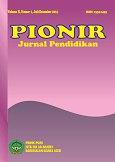TEACHING AND LEARNING ENGLISH USING GOOGLE CLASSROOM AT SMK BUDISATRYA MEDAN DURING COVID-19
DOI:
https://doi.org/10.22373/pjp.v11i1.13089Keywords:
Google Classroom, Teaching and Learning English.Abstract
The use of technology in teaching and learning process is inevitable. The Covid-19 pandemic has insisted the teaching learning process conducted online. Google Classroom is one of online learning platform used by teachers and students in SMK Budisatrya Medan. This study is aimed at describing the teaching and learning English by using Google Classroom at SMK Budisatrya Medan during Covid-19 pandemic. This study belongs to descriptive study. The participants in this study are all English teachers and students of SMK Budisatrya Medan. The result shows that teaching and learning English by using Google Classroom gives advantages for both teachers and students. The advantages are the ease of access, easy to operate, flexible time of teaching and learning, and supporting various learning sources. However, the teaching and learning using Google Classroom cannot be done optimally because of the lack of facilities experienced by some students and unsupportive communication feature of the application.
References
ASIAN DEVELOPMENT BANK. “Covid19 Impact on Technical and Vocational Education and Training in Sri Lanka.” ADB BRIEFS 01, no. 168 (2021): 1–8.
https://doi.org/http://dx.doi.org/10.22617/BRF210081.
Astuti, Tihfani, and Lilia Indriani. “The EFL Students Perceptions in Using Google Classroom for English Learning during Pandemic.” Jurnal Review Pendidikan Dan Pengajaran 03, no. 02 (2020): 328–35. http://journal.universitaspahlawan.ac.id/index.php/jrpp.
Efriana, Leli. “Problems of Online Learning during Covid-19 Pandemic in EFL Classroom and the Solution.” Journal of English Language Teaching and Literature 02, no. 01 (2021): 38–47. https://jurnal.stkipmb.ac.id/index.php/jelita/article/view/74.
Isda, Irma Dewi, Imran Imran, Purwati Purwati, and Rahmiati Rahmiati. “The Effectiveness of Google Classroom in Teaching English during Covid-19 at SMA N 1 M Payed.” Journal of Research on English and Language Learning 02, no. 01 (2021): 54–60.
https://doi.org/http://dx.doi.org/10.33474/j-reall.v2i1.9518.
Islam, Sadequle, and Syeda Afsana Ferdousi. “Techno-Aide Google Classroom for Learning English : Prospects & Challenges.” Journal on Todays Ideas-Tomorrows Technologies 07, no. 02 (2019): 106–17.
https://doi.org/10.15415/jotitt.2019.72006.
Okmawati, Mike. “The Use of Google Classroom during Pandemic.” Journal of English Language Teaching 09, no. 02 (2020): 438–43.
http://ejournal.unp.ac.id/index.php/jelt.
Rahayu, Retno Puji, and Yanty Wirza. “Teachers Perception of Online Learning during Pandemic Covid -19.” Jurnal Penelitian Pendidikan 20, no. 03 (2020): 392–406.
Salam, Urai. “The Students ’ Use of Google Classroom in Learning English.” Jurnal Pendidikan Indonesia 09, no. 04 (2020): 628–38.
https://doi.org/10.23887/jpi-undiksha.v9i4.27163.
Sholah, Hanif Maulaniam. “Teaching and Learning English Using Google Classroom for Indonesian Learners.” Jurnal Pusaka 08, no. 01 (2020): 1–12. http://ejournal.alqolam.ac.id/index.php/jurnal_pusaka/article/view/375.
Somekh, Bridget, and Niki Davis. Using Information Technology Effectively in Teaching and Learning. New York: Routledge, 2005.
Sukmawati, and Nensia. “The Role of Google Classroom in ELT.” International Journal for Education and Vocational Studies 01, no. 02 (2019): 142–45. https://doi.org/DOI:
https://doi.org/10.29103/ijevs.v1i2.1526.
Wiranegara, Dian Arsitades, and Sohibul Hairi. “Conducting English Learning Activities by Implementing Telegram Goup Class during Covid-19 Pandemic.” Journal of English for Academic and Specific Purposes 3, no. 2 (2020): 104–14.
https://doi.org/doi.org/10.18860/jeasp.v3i2.11122.
Zboun, Jomana S, and Mohammed Farrah. “Students Perspectives of Online Language Learning during Corona Pandemic: Benefits and Challenges.” Indonesian EFL Journal 07, no. 01 (2021): 13–20.
Downloads
Published
Issue
Section
License
- Authors retain copyright and grant the journal right of first publication with the work simultaneously licensed under a Creative Commons Attribution License that allows others to share the work with an acknowledgment of the work's authorship and initial publication in this journal.
- Authors are able to enter into separate, additional contractual arrangements for the non-exclusive distribution of the journal's published version of the work (e.g., post it to an institutional repository or publish it in a book), with an acknowledgment of its initial publication in this journal.
- Authors are permitted and encouraged to post their work online (e.g., in institutional repositories or on their website) prior to and during the submission process, as it can lead to productive exchanges, as well as earlier and greater citation of published work (See The Effect of Open Access).

